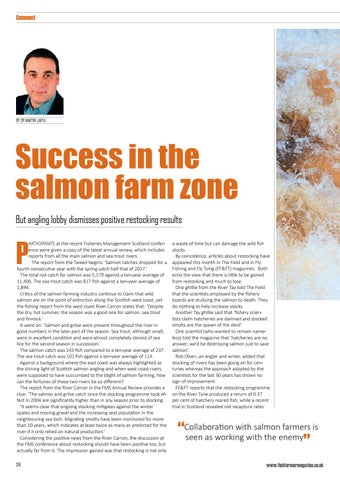Comment
BY DR MARTIN JAFFA
Success in the salmon farm zone But angling lobby dismisses positive restocking results
P
ARTICIPANTS at the recent Fisheries Management Scotland conference were given a copy of the latest annual review, which includes reports from all the main salmon and sea trout rivers. The report from the Tweed begins: ‘Salmon catches dropped for a fourth consecutive year with the spring catch half that of 2017.’ The total rod catch for salmon was 5,179 against a ten-year average of 11,406. The sea trout catch was 817 fish against a ten-year average of 1,894. Critics of the salmon farming industry continue to claim that wild salmon are on the point of extinction along the Scottish west coast, yet the fishing report from the west coast River Carron states that: ‘Despite the dry, hot summer, the season was a good one for salmon, sea trout and finnock.’ It went on: ‘Salmon and grilse were present throughout the river in good numbers in the later part of the season. Sea trout, although small, were in excellent condition and were almost completely devoid of sea lice for the second season in succession.’ The salmon catch was 243 fish compared to a ten-year average of 237. The sea trout catch was 101 fish against a ten-year average of 114. Against a background where the east coast was always highlighted as the shining light of Scottish salmon angling and when west coast rivers were supposed to have succumbed to the blight of salmon farming, how can the fortunes of these two rivers be so different? The report from the River Carron in the FMS Annual Review provides a clue: ‘The salmon and grilse catch since the stocking programme took effect in 2004 are significantly higher than in any season prior to stocking. ‘It seems clear that ongoing stocking mitigates against the winter spates and moving gravel and the increasing seal population in the neighbouring sea loch. Migrating smolts have been monitored for more than 10 years, which indicates at least twice as many as predicted for the river if it only relied on natural production.’ Considering the positive news from the River Carron, the discussion at the FMS conference about restocking should have been positive too, but actually far from it. The impression gained was that restocking is not only
24
Martin Jaffa.indd 24
a waste of time but can damage the wild fish stocks. By coincidence, articles about restocking have appeared this month in The Field and in Fly Fishing and Fly Tying (FF&FT) magazines. Both echo the view that there is little to be gained from restocking and much to lose. One ghillie from the River Tay told The Field that the scientists employed by the fishery boards are studying the salmon to death. They do nothing to help increase stocks. Another Tay ghillie said that ‘fishery scientists claim hatcheries are damned and stocked smolts are the spawn of the devil’. One scientist (who wanted to remain nameless) told the magazine that ‘hatcheries are no answer; we’d be destroying salmon just to save salmon’. Rob Olsen, an angler and writer, added that stocking of rivers has been going on for centuries whereas the approach adopted by the scientists for the last 30 years has shown no sign of improvement. FF&FT reports that the restocking programme on the River Tyne produced a return of 0.37 per cent of hatchery reared fish, while a recent trial in Scotland revealed rod recapture rates
on with salmon farmers is “Collaborati seen as working with the enemy ” www.fishfarmermagazine.co.uk
06/05/2019 09:50:48
